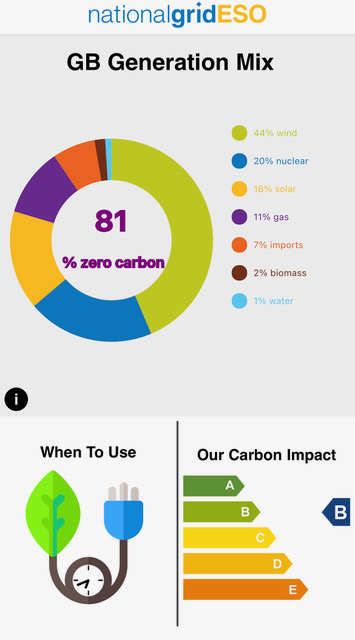Jigsaw has been pushing for changes to the way electric heating is measured against other forms of heating for years. This has been carried out by meeting with Lords, MPs, Government officials, BEIS and the BRE. We are happy to announce that some of the changes we have been requesting are starting to happen this year.
There has to be many changes made to our building processes if we are to continue with the push to Net Zero for 2050. The BRE are making those changes from June 2022. The 2022 release marks the longest period of no change since its inception in 1993. The last revise was 2012. And, a lot has changed in that time. The key point being the decarbonisation within our national grid. Today, 24/4/22, the National Grid ESO app was showing an 81% use of green energy.
This is being achieved by a number of sources such as wind, solar, hydro and nuclear. This is important as the electric that we are using is becoming greener and greener.
Why Is SAP Important?
The SAP (Standard Assessment Procedure) is important as it is a calculation used to measure a buildings performance, called the EPC. SAP calculates energy use and associated metrics including running costs and CO2 emissions of the building. The buildings are rated from A-G. A being the most efficient performing.
The issue for electric heating prior to this change has been the outdated representation of where our electric is being derived from. Historically, electricity has been produced from burning gas, coal and other fossil fuels. Currently, the amounts of green energy being generated has increase significantly and the carbon emissions (CO2) for electricity is reducing. However, these changes have not been recognised by SAP.
According to the BRE (Link, accessed 24/4/22), “the calculation is based on the energy balance, taking into account a range of factors that contribute to energy efficiency:
- Materials used for construction of the dwelling
- Thermal insulation of the building fabric
- Air leakage ventilation characteristics of the dwelling, and ventilation equipment
- Efficiency and control of the heating system(s)
- Solar gains through openings of the dwelling
- The fuel used to provide space and water heating, ventilation and lighting
- Energy for space cooling, if applicable
- Renewable energy technologies”
SAP 10.2
- fuel prices, CO2 emissions and primary energy factors have been updated
- the monthly variation of CO2 and primary energy factors is now taken into consideration
- the calculation of hot water consumption has been adjusted to take account of the shower flow rate
- the self-use factor for electricity generated by photovoltaic (PV) systems has been revised and allows for the effects of battery storage and PV diverters
- the assumed standard heating pattern has been adjusted to better match UK practice
What Does This Mean For The Home?
Moreover, the calculations for SAP are applied differently for new build and retrofit properties. Still the recommended combination for heating and hot water is the same a new or exiting build is:
Infrared heating – With smart controls per room.
Smart Hot water cylinder – With PV switch to divert electricity to the cylinder from solar panels.
Solar PV – If possible. A battery can be used on it’s own.
Battery storage – Storing any excess energy and deploying it when needed. Or, charging off a cheap rate electric tariff. I currently do this at my own home and charge the electric car at the same time.
This combination for either new or retrofit building will raise the environmental section of the EPC to an A*.
RETROFIT Diagram
The diagram shows the increase for a retrofit installation moving from Gas to Electric heating.

NEW Building Diagram
Whereas, the diagram shows a decrease from a B to a C but a pass a new build installation moving from Gas to Electric heating.
At present the New building SAP is hindered by the lack of the Q appendix code for infrared heaters. This will be updated as we move to SAP 11 calculations.

How Can We Improve?
In addition, we have seen from our data and the feedback from our clients that IR can make a considerable difference to energy bills. In order to evidence this saving made by infrared technology there needs to be a considerable amount of real world testing. Because, at the end of the testing process the BRE award a Q appendix code. Importantly, this allows the SAP assessors to note the products being used and energy savings. Therefore, providing a much more accurate calculation of the building. Currently, there is no Q appendix code for infrared heating.
>> Wolverhampton University Study <<
The data that Jigsaw has from two university studies show that our panels use 50-60% less energy than a convection heater or storage heater. Moreover, on SAP all three heating types are grouped as electric heaters even though the savings with IR can be considerable for the home and environment. This is where the Government, BRE and BEIS need to step up to find more achievable methods to decarbonise home and commercial properties.

Building For The Future
Moving forward the winning combination for a reduced carbon home will be one that doesn’t require much heating. Moreover, future regulations for buildings are moving forward to a passive build. These properties will be highly insulated with a very low demand for heating. A standard building would require around 50w/m2 of heating. Whereas, a passive building will require 10w/m2. The largest consumption of energy in that property will become the hot water.
Therefore, an ASHP or GSHP will not be required as they are a considerable cost for a low heat demand and are required to provide a constant level of heat. However, an infrared system is the opposite. The heat can be called on demand per room by temperature or motion. Plus, there is no maintenance.
In conclusion, please contact Jigsaw if you would like us to calculate your buildings heating requirements. Jigsaw also calculates, supplies and installs for a range of domestic, commercial, religious and social housing buildings.
*Disclaimer – All buildings require their own SAP calculations. Speak to your SAP assessor and ask them to calculate based on the current SAP figures.


